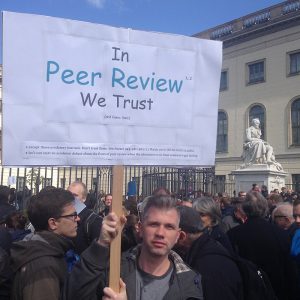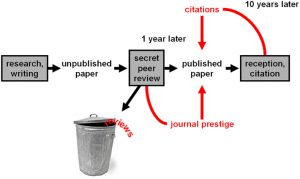
Peer review is an integral part of scholarly communications. It is a matter of pride for a researcher to receive an invitation of peer review. This process of peer review is carried out for every manuscript intended to be published in a journal or a book.
To perform the peer review of an article, journal editors only invite researchers who have done valuable and commendable work in their field of expertise. These distinguished academics are entrusted with the job of evaluating the manuscript of another researcher in the same field.
What is peer review in scholarly publishing?
Although it is honorable to be a peer reviewer, there are a lot of responsibilities associated with this position. The main goal of peer review is to determine whether the work of another researcher is good enough to be published in a scientific journal.
According to the editor of the journal Biochemia Medica, a peer reviewer is expected to objectively analyze the manuscript of another researcher.After thoroughly examining the manuscript, the peer reviewer has to provide constructive feedback to the author in the form of comments.
Depending upon the quality of research work, peer reviewers may consider it to be commendable enough for publication or they may reject a manuscript for poor presentation of scientific facts.
Tips for being a good peer reviewer of journal articles
1. Acceptance or rejection of invitation: A peer reviewer has to consider many factors while deciding whether to accept or reject the invitation sent by a journal editor. Among these factors, subject matter expertise is of prime importance.
A peer reviewer must first go through the abstract of the article to surmise his or her expertise in the given subject. Although journal editors extend their invitation to distinguished academics, there are chances of a researcher not being an expert in that particular topic. In such instances, a peer reviewer may reject the invitation of the journal.
Another important factor is time constraints. Researchers are normally busy people working for about 50 hours in a week. They have to carry out experiments, collaborate with other laboratories, and work on their own manuscripts.
However, they may spend some hours on weekends exploring the work of other researchers. In general, journal editors provide them about three weeks to complete a peer review. If a researcher is pressed for time, they should politely decline the invitation.
2. Academic misconduct: In a manuscript, researchers have to often cite the work of other related studies. In such cases, ESL authors find it hard to paraphrase the findings of previous research studies. They are often accused of plagiarism by journal editors.
Although the academic community may trust their peers, that is, colleagues, peer reviewers should always check the manuscript for plagiarism issues. They can thus detect academic misconduct of authors. Peer reviewers have the authority to reject a paper on issues of plagiarism.
Sometimes, authors may present exemplary results in their manuscript. However, a peer reviewer should double check such results by repeating the experiment in his or her laboratory and with the same equipment. In this way, peer reviewers can catch hold of authors presenting false data.
3. Scope and objective of the journal: A peer reviewer should always look for the scope and objective of the journal. The target audience of the journal should also be considered. If a researcher has received a journal editor’s invitation for the first time, the researcher should make it a point to read few of the published papers from that journal. Moreover, the author information presented on the journal’s website should also be considered.
4.Title of the article: A peer reviewer should thoroughly judge the suitability of the article’s title. The title should be presented in a lucid language and should not contain unnecessary jargon. It should clearly reflect the content of the article. Although a peer reviewer may suggest improvements in the title, the author should not be compelled to have a style that super-imposes the style of the reviewer.
5. Review the article’s content: The main objective of the peer review process is to determine the novelty factor of the results presented in the manuscript. A reviewer has to peruse through the document to understand whether the content adds something new to their area of expertise.
The view-points of the peer reviewers may be subjective, but they can certainly make the process more transparent. For this purpose, they must check whether the manuscript is concisely summarized in the abstract. Moreover, the references presented in the bibliography must be precise, reliable, and sufficient to support the claims made in the literature.
A peer reviewer should thoroughly check whether there are any omissions of citations in the reference list. They should then point out this error in their feedback to the author. A peer reviewer should also check whether the author has justified all the claims with adequate data and results. If not, the peer reviewer must suggest ways to justify all the arguments and claims.
The author has to provide sufficient data for the reproducibility of results. A peer reviewer is not required to point out English language errors or inconsistencies in citation styles. However, a peer reviewer must mention the need for copy-editing in their comments to the author.
6.Accept or Reject Decision: A peer reviewer will rarely come across a paper that does not need any suggestions for improvement. If there are some issues that need to be corrected in a paper, the peer reviewer has to give the following decision: “Accept with minor revisions”. This is a favorable outcome for most authors, and the job of the peer reviewer is completed.
If the author has presented novel results but has not provided sufficient evidence, a peer reviewer may suggest major rewriting of the paper. The decision of the peer reviewer would thus be “Accept with major revision.” Some journals may prefer calling the decision as “Revise and resubmit.” In such cases, the paper may be again submitted for a second round of peer review.
If the paper is poorly written and offers no novelty factor, the reviewer would not recommend it for publication. In such cases, the decision of the reviewer would be outright “Reject.” There are instances where the content of the paper does not match with the scope and objectives of the journal.
In such cases, the authors must carefully consider another journal to avoid instances of mismatch. To tackle cases of journal mismatch, peer reviewers must not “reject” the paper outright but suggest the names of appropriate peer reviewed journals




